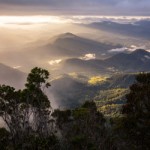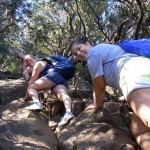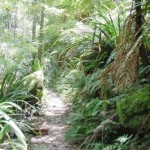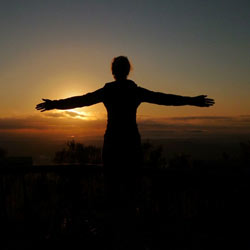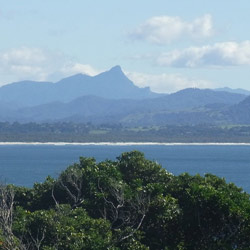About Mount Warning
At 1156m, Mount Warning dominates the Byron Bay hinterland landscape. As Byron Bay is the most easterly point of Australia, Mount Warning is the highest point in the region and this is where the sun first hits mainland Australia. Named by National Geographic as one of the 10 Best Mountain Climbs in Australia, a Mount Warning climb is a must-do for visitors to the Byron Bay region. Whether you choose to climb the 9km, four hour return hike at sunrise or during the day, the experience is guaranteed to be unforgettable with the summit offering 360 degree panoramic views. Here, the mountain’s volcanic origins are apparent with Mount Warning the central vent of an ancient volcano.
Don’t be daunted by Mount Warning’s height. The paths are configured into a zigzag so that you are proceeding at a fairly gentle incline. The paths are all natural and can be slippery when wet or in the dewy morning. As Mount Warning is within the Wollumbin National Park which is part of the Gondwana Rainforests, it is always going to be a little damp even on the hottest day. It is recommended that you travel with a small group, who will encourage you in the climb. The average time for a Mount Warning climb is about 2 hours and is an experience best shared.
The climb is not just for the very fit, however it is quite arduous. Remember, though, it is not a race and you can proceed at your own pace. Basically, the Mount Warning climb is attainable by any fitness level. The degree of difficulty only really increases during the final ascent. The last 300m or so are pretty much vertical, however there is a chain embedded into the rock for assistance. This, of course, is great for the climber looking for a little extra adrenaline and effort. An early morning Mount Warning climb is most memorable when you reach the summit as the sun comes up. Dusk walks of Mount Warning are equally enchanting with spectacular sunset views. The views from the top are made comprehensible by maps in each direction informing you of what you are seeing. The mountain is strangely flat on top and is well equipped with seats.
Named ‘Wollumbin’ by the indigenous traditional owners, the Bunjalung people, Mount Warning has long been a place of indigenous cultural law, initiation and spirituality. The first mention of Mount Warning in recorded history is by Captain Cook who named it Mount Warning to alert future sea travellers of the dangerous offshore reefs. The mountain itself is home to a microcosm of Australian native animals from wombats and platypus to tiny forest dwelling insects. The soundtrack of your Mount Warning walk will be the beat, hum and buzz of a million creatures and the slow drip of old rainforest. Be aware, too, that the Mount Warning weather can change quite quickly and dramatically. The indigenous ‘nickname’ for Mount Warning, ‘the cloud catcher’, is very appropriate. When shrouded in gentle mist and cloud, the Mount Warning climb becomes very enchanting with rushing streams and waterfalls.
As you go up and then down, you will be amazed at the variety of climbers on the mountain, too. From intrepid mountain climbers, to awestruck backpackers, to children (who are capable of passing you) and their parents. There is a lovely camaraderie on the mountain as those coming down will often let you know ‘not far now’.
Byron Bay Adventure Tours makes camping and climbing Mount Warning easy by providing everything, including food and accommodation.
Please note that Byron Bay Adventure Tours does not operate within Wollumbin National Park and that therefor the actual climb of Mt Warning is self-guided.


